A small bit of aviation history is made as the Australian airline’s last 747-400 flies for the final time to its resting place in the Mojave desert
by Brigid Delaney in Sydney. Photographs by Carly Earl
There is a place on a Boeing 747 that you’ve probably never seen.
At the back of the giant plane there is a panel that opens up to an incredibly narrow set of stairs. Squeeze your way up these and you come to a small cavity where eight slender beds are wedged in Jenga-style configuration, with curtains for privacy.
It’s like the basement in Parasite, but in the sky, and more cramped.
You have to ask yourself how anyone could sleep up here without having a panic attack. But the crew of a 747 has to do just that – or at least used to.
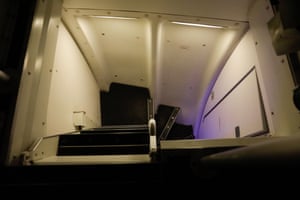
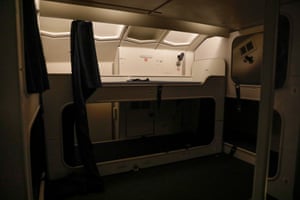
The secret room is just one of a number of oddities that will soon disappear forever. The 747 – the original jumbo jet – is soon to be no more.
Qantas’s last model departed Sydney for the final time on Wednesday, bringing to an end five decades of service. The planes, with their distinctive shape of a hump-like upper deck, have been flying in Australia since 1971.
The retirement was always on the cards, but the date was brought
forward six months due to the ravaging effects of Covid-19 on the
aviation industry. This week British Airways also retired their 31-strong fleet of 747s, citing the pandemic and a major downturn in travel.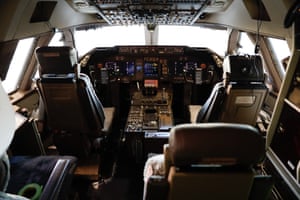

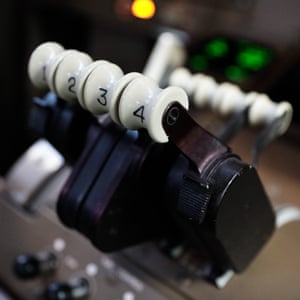
The tour had a dystopian edge. Without the aircon or lights on, the cabin was super-hot and dark. Entering via the back of the plane, there was a gaping hole where the seats in rows 61 to 64 had been ripped out. The carpet was gashed where the seats had been.
On the plastic around the windows and the armrests were messages scrawled in texta: “Goodbye 747 you’ll be missed – 25 years of flying with you was a pleasure”, “Kim was here :) Farewell Queen”.
The disorientating effect of boarding the plane (a plane without passengers, a plane that was not going to take you anywhere, a plane with seats missing) was intensified when surveying the airport. Apart from one tiny plane, no flights were taking off. Aircraft were parked. The runways were empty. There were no passengers.
There was so much symbolism, it seemed to be screaming: “An epoch is ending!”
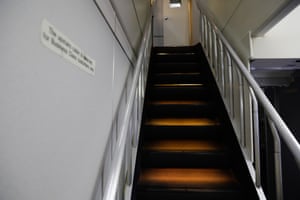
Qantas Group CEO Alan Joyce said in a statement that the 747 was significant as it bought in a new era of lower fares and nonstop flights.
“It’s hard to overstate the impact that the 747 had on aviation and a country as far away as Australia. It replaced the 707, which was a huge leap forward in itself but didn’t have the sheer size and scale to lower airfares the way the 747 did. That put international travel within reach of the average Australian and people jumped at the opportunity,” Joyce said.
Although beloved by passengers and crew alike, the 747s were environmentally unsound, often cited as a worst-offending model by Heathrow when it published its league tables of the noisiest, most polluting airlines.
But there was no doubt in talking to pilots and engineers, that this plane was deeply loved.
Qantas pilot Ewen Cameron, a 747 pilot for 40 years, said: “It’s a great aeroplane. It’s so heavy but it’s really stable. You point it in one direction, it keeps going in that direction. It’s very forgiving. It’s just been part of my life. The passengers love the [Airbus] A380 but there’s a more nostalgic love for this one.”

“Everything works really well. There is nothing cumbersome about it,” said Cameron. “It looked cumbersome when I first saw it – I was struck by the pure size. I have a fair understanding of aerodynamics, but watching it take off you think, ‘that shouldn’t happen’”.
It shouldn’t, but it did. Over and over again.

A workforce of 50,000 that called itself “the Incredibles” built the aircraft in less than 16 months.

John Sutter, Boeing’s 747 engineer, wrote of the 1969 maiden flight: “I saw Boeing’s new jet as 75,000 drawings, 4.5 million parts, 136 miles of electrical wiring, five landing gear legs, four hydraulic systems, and 10 million labour hours.”
Since that day the planes have transported 5.9 billion people, nearly 80% of the world’s population, Boeing says.
The other 20% have missed out.
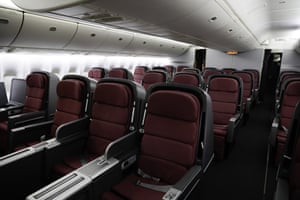
Then we each got a turn at sitting in business class in the big old leather (or leather-feel) chairs that had a scotch, cigar and fireplace vibe. Once you sunk into a business class seat, it was difficult to get up.
Around 4pm, Qantas had to move the plane from the hanger. We all got off and stood on the bridge.
The enormous plane was pushed out on wheels that seemed comically too small to carry such weight. But it moved gracefully, and although not airborne, seemed to glide across the tarmac, more like an ocean liner than a plane. The word magisterial came to mind.
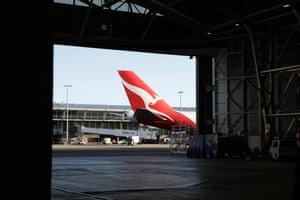
The scene in the hangar, as the plane was wheeled out, felt reminiscent of a funeral procession, where people line the roads and pay respects as the hearse rolls by slowly.
But here, engineers and maintenance workers stood on the bridge, watching the plane roll out, their arms outstretched, filming the departure on their cameras. It was a moment that almost seemed choreographed, it was so like a salute.
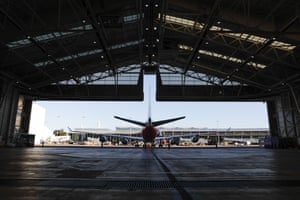
No comments:
Post a Comment